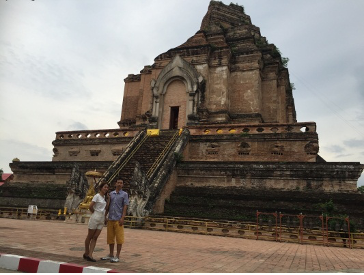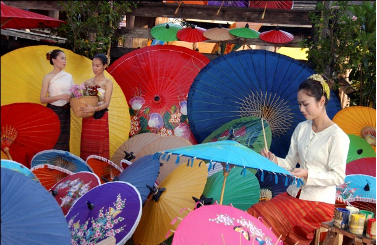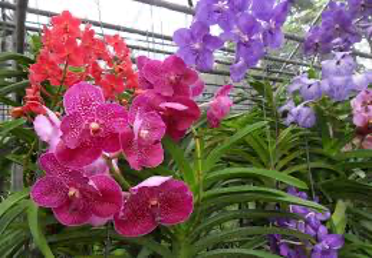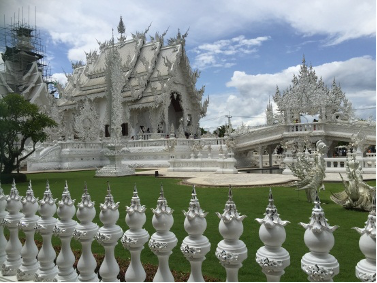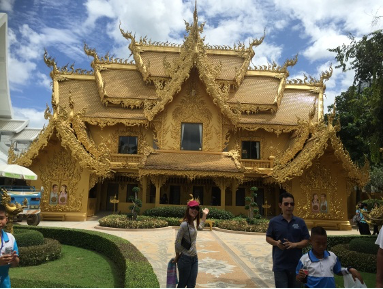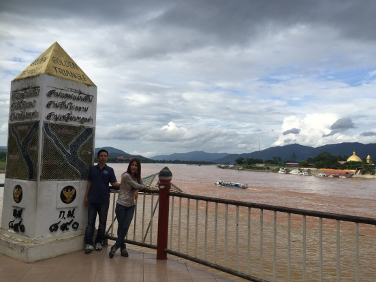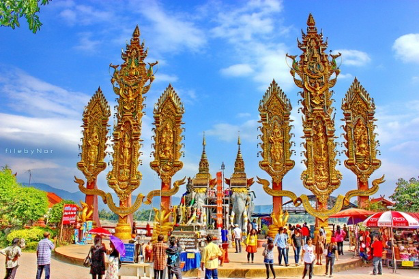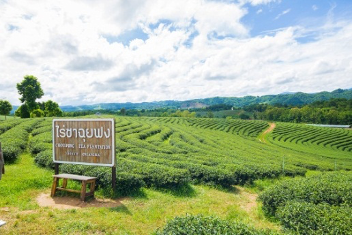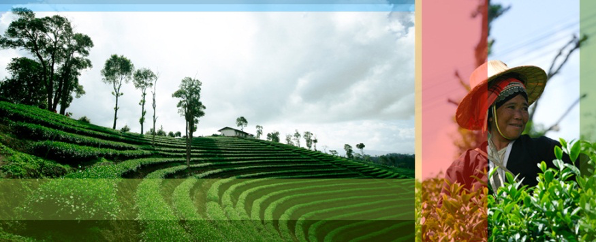Tag 01: Bangkok- Uthai Thani – Sukhothai (ca.480 km)
Nachdem Frühstück fahren ca. 3 Studen nach Uthai Thani. Dort besichtigen wir den gläsernen Tempel Wat Thasung, auch Spiegeltempel genannt. Der Wat Thasung gehört zu den weltweit größten Tempelbauten, bei denen in großem Umfang als Baumaterial Glas
und Spiegel verwendet wurden.
Day 1: Bangkok- Uthai Thani – Sukhothai (ca.480 km)
After breakfast drive about 3 hours to Uthai Thani. There we visit the glass temple Wat Thasung, also called the mirror temple. Wat Thasung is one of the world’s largest temple buildings, in which glass is used extensively as a building material and mirrors were used.
We drive further up North to Khampaeng Phet : Founded in 1347, Khamphaeng Phet was a garrison town of the kings of Sukhothai and Ayutthaya. The ruins of numerous buildings can still be seen. The city now has 35000 inhabitants and is similar to Sukhothai but not as spectacular.
On the way to Khampaeng Phet we will visit monkey temple.
Visit the Sukhothai Historical Park, the cradle of Thailand, which has been a UNESCO World Heritage Site since 1991. Let’s ride bikes in History Park
Sukhothai has 30,000 inhabitants and is divided into two different parts of the city that couldn’t be more different. New Sukhothai is a provincial backwater that doesn’t have much to offer. On the other hand, Old Sukhothai, 12 km to the west, is one of the most impressive ruined cities ever! Founded in 1238, Sukhothai was the capital of the first Thai nation for 120 years. Sukhothai’s King Ramkanghaeng (1275-1317) is commonly referred to as the father of the nation.
Fahren wir nach Khampaeng Phet : Gegründet im Jahre 1347, war Khamphaeng Phet eine Garnisionsstadt der Könige von Sukhothai und Ayutthaya. Die Ruinen von zahlreichen Bauwerken sind noch zu besichtigen. Die Stadt hat heute 35000 Einwohner und ist ähnlich wie Sukhothai, aber nicht so spektakulär.
In Khampaeng Phet machen wir Bekanntschaft mit den Affen und beobachten die Rasselbande im direkten Kontakt!
- Besuchen des Sukhothai Geschichtsparks der Wiege Thailands, die seit 1991 zum Weltkulturerbe der UNESCO zählt. Fahren wir Fahrad im Gechictepark
- Sukhothai hat 30.000 Einwohner und unterteilt sich in zwei verschiedene Stadtteile, so wie sie unterschiedlicher nicht sein könnten. New Sukhothai ist ein Provinznest, das nicht viel zu bieten hat. Das 12km westlich gelegene Old Sukhothai ist dagegen eine der imposantesten Ruinenstädte überhaupt! Sukhothai wurde 1238 gegründet und war 120 Jahre lang die Hauptstadt der ersten Thai–Nation.Sukhothais König Ramkanghaeng (1275–1317) wird allgemein als Vater der Nation bezeichnet.
Day 02: Sukhothai – Chiang Mai
Continue to Chiangmai Wat Phra That Doi Suthep is a Buddhist temple complex (wat) in Chiang Mai, Northern Thailand. It is a Second Class Royal Temple. Wat Phra That Doi Suthep is the landmark of Chiang Mai and is located about 15 km west of the city center. Particularly well-known is the gilded chedi, which is said to contain a relic of the Buddha. The temple complex itself can be reached via a long Naga staircase and elevator.
Tag 02: Sukhothai– Chiang Mai
- Fahren weiter nach Chiangmai Wat Phra That Doi Suthep ist eine buddhistische Tempelanlage (Wat) in Chiang Mai, Nordthailand. Er ist ein Königlicher Tempel Zweiter Klasse.Wat Phra That Doi Suthep ist das Wahrzeichen Chiang Mais und liegt etwa 15 km westlich vom Stadtzentrum. Besonders bekannt ist die vergoldetete Chedi, die eine Reliquie des Buddha enthalten soll. Die Tempelanlage selbst erreicht man über eine langgezogene Treppe, deren Geländer mit Schlangen verziert sind.
- Phuping Palast und Doi Pui
- Wat Chedi Luang etwa Tempel (der königlichen Stupa) ist eine buddhistische Tempelanlage (Wat) in Chiang Mai in der Provinz Chiang Mai. Er ist ein Königlicher Tempel Dritter Klasse
Visit Wat Chedi Luang Rough Temple (the Royal Stupa) is a Buddhist temple complex in Chiang Mai in Chiang Mai Province. It is a Third Class Royal Temple
- Abend gehen zum Traditionalenessen (Khun Tok)
Evening go to traditional dinner (Khun Tok)
Day 3: Chaing Mai city tour
Visit Bo Sang. We drive towards San Kampheng is the Handicraft Center, where the traditional paper parasols are made. Here you can cheaply buy the traditional paper parasols from Thailand.
Orchid Farm : For orchid lovers, there are various species of orchids and some butterflies at the orchid farm (Nam Phung Orchid Farm) in Mae Rim, which is 20 km from Chiang Mai
Drive to Chiang Rai
Visit The White Temple (Wat Rong Khun). Wat Rong Khun (‘White Temple’), located about 20 kilometers outside the city center – in Tambon Ao Don Cha pay off As the name suggests, the temple is completely white and has been worked out down to the smallest detail. For the artist – Chalermchai Kositpipat – his masterpiece, which he and his team started in 1998 and has not yet fully completed, symbolizes paradise. Inside you can discover numerous modern murals of famous people and cartoon characters.
Tag 3: Chaing Mai Satadtrundfahrt
- Besuchen Bo Sang. Auf der Straße Richtung San Kampheng befindet sich das Handicraft Center, wo die traditionellen Papier-Sonnenschirme hergestellt werden. Hier kann man günstig die traditonellen Papier-Sonnenschirme aus Thailand kaufen.
- Orchideenfarm : Für Orchideenliebhaber gibt es in der Orchideenfarm (Nam Phung Orchid Farm) in Mae Rim, die 20 km von Chiang Mai entfernt liegt, verschiedene Orchideenarten zu bewundern und einige Schmetterlinge
- Fahren weitet nach Chiang Rai
- Besuchen Der White Temple (Wat Rong Khun) Wenn Sie in Chiang Rai sind, sollten Sie auf jeden Fall dem Wat Rong Khun (‚Weißer Tempel‘), der etwa 20 Kilometer außerhalb des Stadtzentrums – in Tambon Ao Don Cha – liegt, einen Besuch abstatten. Der Tempel ist – wie der Name schon verrät – vollständig in Weiß gehalten und ins kleinste Detail ausgearbeitet. Für den Künstler – Chalermchai Kositpipat – symbolisiert sein Meisterwerk, das er 1998 mit seinem Team begann und bislang noch nicht vollständig abgeschlossen hat – das Paradies. Im Inneren können Sie zahlreiche moderne Wandmalereien von berühmten Personen und Comicfiguren entdecken.
Tag 4: Chiang Rai Ausflug
Goldenes Länderdreieck
Day 4: Chiang Rai Excursion
Golden triangle of countries; The famous Golden Triangle is a day trip from Chiang Rai in the Chiang Saen district. The tri-border region of Thailand, Laos and Myanmar was once an opium-growing region where there was a brisk trade in the plants. Today you can enjoy the view of the countries there or take a boat trip to explore the Mekong, which serves as a natural border. If you want to learn something about the history of opium cultivation, the “Hall of Opium” museum, which is a little off the beaten path, is a real insider tip.
Visit Tea platation
- Das berühmt-berüchtigte Goldene Dreieck liegt einen Tagesausflug von Chiang Rai entfernt in dem Bezirk Chiang Saen. Das Dreiländereck Thailand, Laos und Myanmar war einst Opiumanbaugebiet, in dem ein reger Handel der Pflanzen stattfand. Heute können Sie dort die Aussicht auf die Länder genießen oder auf einer Bootsfahrt den Mekong, der als natürliche Grenze dient – erkunden. Wollen Sie etwas zur Geschichte des Opiumanbaus erfahren, ist das etwas abseits gelegene Museum “Hall of Opium” ein wahrer Geheimtipp.
- Tee Berg










